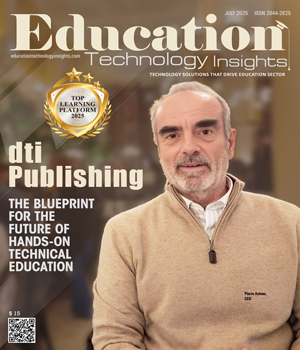THANK YOU FOR SUBSCRIBING
Be first to read the latest tech news, Industry Leader's Insights, and CIO interviews of medium and large enterprises exclusively from Education Technology Insights
Making Education Equitable in the Digital Space
Brian Gall, Director of Learning Experience Design at Villanova University
Through this article, Brian Gall, Director of Learning Experience Design at Villanova University, discusses the importance of digital accessibility in higher education. Reflecting on his time as Assistant Dean of Online and Digital Programs at Albright College, Gall details the development and implementation of the Digital Accessibility Program (DAP). He highlights the challenges and successes in making online course content accessible, including mandatory training for faculty, creating accessible course materials and ongoing support systems. Gall emphasizes the collaborative efforts required to achieve high accessibility standards and expresses his commitment to bringing similar initiatives to Villanova University.
Introduction
In the ever-evolving landscape of higher education, ensuring equal access to educational content is paramount. While I was at Albright College as the Assistant Dean of Online and Digital Programs, The Department of Digital Learning and Innovation took significant steps to address digital accessibility through our Digital Accessibility Program (DAP).
The Backstory
Starting in the Fall of 2020, during the height of the COVID-19 pandemic and transition to ‘Emergency Remote Teaching,’ we collaborated with faculty to tackle accessible content in our online courses. Surprisingly, there was no official policy, training, or requirements for faculty to create 100 percent accessible content. However, Albright College has a strong history of compliance with disability rights legislation, including Section 504 of the Rehabilitation Act of 1973 and Title II for physical and classroom issues.
The Turning Point
With more students taking hybrid and online courses and an increasing number of students with registered disabilities, we knew it was time to act. Our college President requested an Accessibility Policy and that’s when Sherry Young (Director of Student Accessibility and Advocacy) and I stepped up. We gathered feedback from various committees, legal experts, and stakeholders, resulting in an officially approved policy and a call to action for the faculty who designed electronic content for use on our Canvas LMS.
"Faculty and staff often feel underprepared to meet the needs of students with disabilities. But we committed to the process, and by the end of Fall 2023, our fully asynchronous online courses averaged 98.5 percent accessibility."
Faculty Buy-In and Beyond
Our journey was filled with many hurdles. Faculty buy-in, funding, expertise, training, and coordination posed great challenges that had to be overcome. Faculty and staff often feel underprepared to meet the needs of students with disabilities. But we committed to the process, and by the end of Fall 2023, our fully asynchronous online courses averaged 98.5 percent accessibility, according to data provided by Blackboard Ally.
The Big Picture
Our ambitious goal? By the end of the 2025/26 academic year, we wanted to make as much instructional material accessible as possible. Realistically, our goals were for all course content to be 80 percent accessible by May 2024 and 90 percent to be accessible by May 2026. More importantly, the goal for courses where there are identified students with accommodations is to be 95 percent accessible.
How Did We Do It?
1. Mandatory Training for New Hires
One of the first steps is requiring all new faculty and staff to complete an asynchronous digital accessibility course hosted on the college's learning management system during their orientation. Successful completion earns a small stipend and a digital badge to display proudly in Canvas and on LinkedIn.
2. Accessible Course Content
In addition to the introductory training, faculty will need to take a deeper dive if their courses are audited and found to have inaccessible content. Those affected will be enrolled in an advanced asynchronous course, earn another stipend and badge and be partnered with a member of the accessibility team to work through updating materials.
3. Fun Ways to Learn
To make the process more engaging, the college hosted 'PDF Makeover' events where faculty received hands-on help transforming inaccessible PDFs into accessible formats in a supportive group environment.
4. Ongoing Training and Resources
After the initial accessibility push, the team offered regular workshops focusing on keeping new content accessible from the start. Faculty and staff could visit the new Accessibility website to find tutorials, help documents and educational resources around Universal Design for Learning principles. The Canvas Help Center was the one-stop shop for all things digital accessibility.
5. Future Departmental Support System
Perhaps most crucially, each academic department will have an appointed faculty accessibility champion/mentor along with a student worker, both trained to assist colleagues within their department. The scheduled rollout for the support system was to occur in Spring, 2024
With a multi-pronged approach focused on training, resources and ongoing support, Albright College is ensuring its digital assets are truly accessible to all students and staff.
Since this article was written, I have moved on to become the Director of Learning Experience Design at Villanova University in Philadelphia, PA. My hope is to bring some of this planning work to the forefront as we grow our graduate and professional education opportunities for students.
Read Also
Our AI Crisis isn't Technical. It's Human.
4 Keys to Managing Change
Active Engagement is the Foundation of Effective Leadership
Empowering Leadership through Innovation in Higher Education
The New Era of Education
Redefining Readiness: A Path Toward a Technology-Agnostic Future

I agree We use cookies on this website to enhance your user experience. By clicking any link on this page you are giving your consent for us to set cookies. More info






















